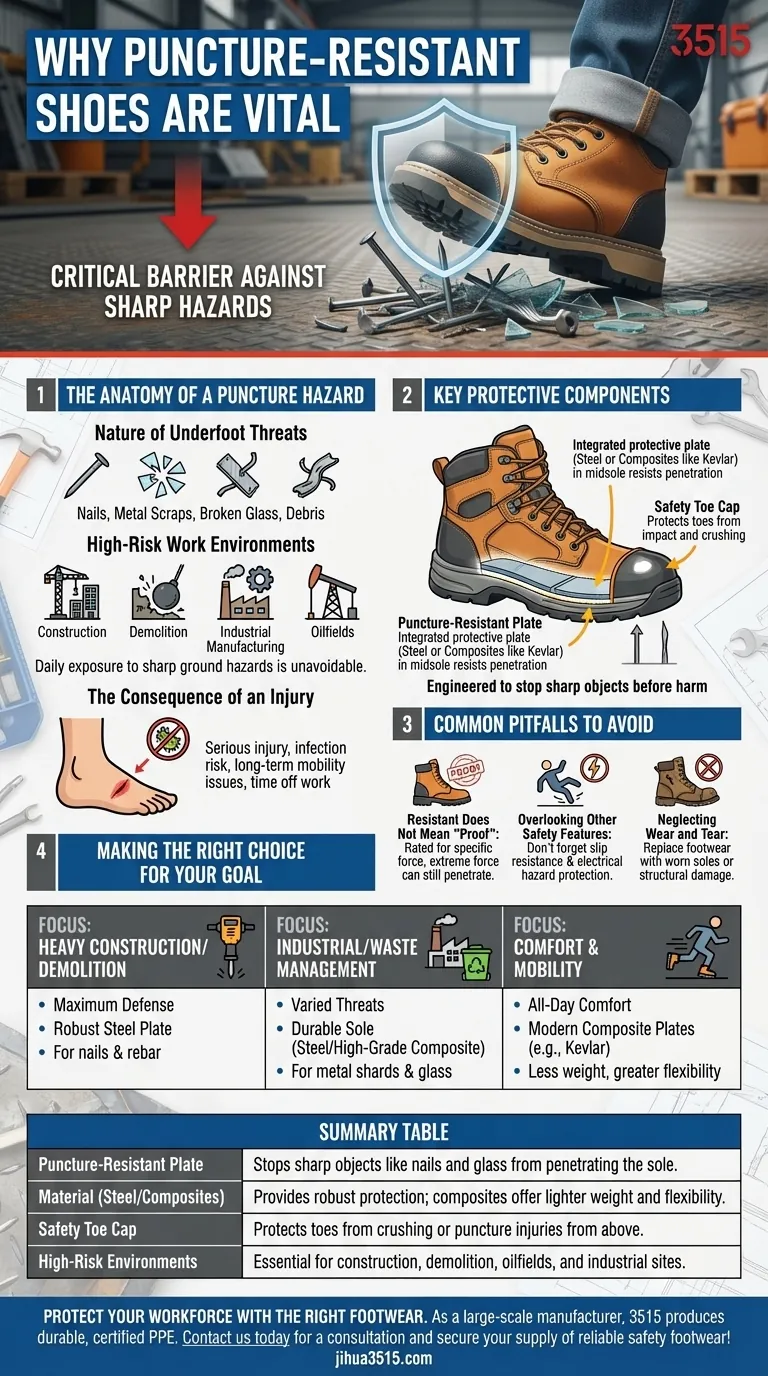The primary importance of puncture-resistant shoes is to provide a critical barrier between your feet and sharp objects on the ground. They are specifically engineered with protective plates in the sole to prevent penetration from hazards like nails, glass, metal scraps, and other debris. This makes them an essential piece of personal protective equipment (PPE) in environments where such risks are prevalent.
The core function of puncture-resistant footwear is not just about meeting a safety standard; it's a proactive measure to prevent severe and debilitating foot injuries. Understanding the specific components that provide this protection is key to selecting the right shoe for your environment.

The Anatomy of a Puncture Hazard
To appreciate the role of this footwear, we must first understand the risks it is designed to mitigate. The dangers present on a worksite often go beyond what is immediately visible.
The Nature of Underfoot Threats
Puncture hazards are common in many industrial and manual labor settings. These threats include discarded nails, sharp metal scraps from fabrication, broken glass, and other jagged shards or debris that can easily pierce a standard shoe sole.
High-Risk Work Environments
This type of protection is crucial in specific industries. Job sites for construction, demolition, industrial manufacturing, and work in oilfields are prime examples where sharp ground hazards are an unavoidable part of the daily environment.
The Consequence of an Injury
A puncture wound to the foot is a serious injury. Beyond the immediate pain, it carries a high risk of infection and can cause deep tissue damage, potentially leading to long-term mobility issues and significant time away from work.
Key Protective Components
Puncture-resistant shoes are not simply heavy-duty boots. They contain specific technological features designed to stop sharp objects before they can cause harm.
The Puncture-Resistant Plate
The core of the protection is a protective plate integrated into the midsole of the shoe, directly beneath the foot. This plate is engineered to resist the force of a sharp object attempting to push through the sole.
Material Composition: Steel and Composites
Traditionally, these protective plates are made of steel, offering robust and reliable protection. Modern footwear also utilizes composite materials, such as Kevlar, which provide comparable puncture resistance with the added benefits of being lighter and more flexible.
Comprehensive Foot Protection
While the sole plate protects from underfoot threats, many of these work boots also include a safety toe cap. This component is vital for protecting the toes from being punctured or crushed by falling objects or impacts from the front.
Common Pitfalls to Avoid
While essential, it's important to have a realistic understanding of what this footwear can and cannot do. Misconceptions can lead to a false sense of security.
"Resistant" Does Not Mean "Proof"
No shoe is completely puncture-proof. These shoes are rated to resist a specific amount of force from a particular object, but an object with extreme sharpness or applied with exceptional force can still pose a risk.
Overlooking Other Safety Features
A puncture-resistant sole is just one piece of the puzzle. For many jobs listed, such as construction or factory work, features like slip resistance and electrical hazard protection are equally critical. Focusing on one feature while ignoring others can leave you vulnerable.
Neglecting Wear and Tear
Like all PPE, puncture-resistant shoes have a limited lifespan. A sole that is heavily worn down or a shoe with visible structural damage may no longer offer the original level of protection and should be replaced.
Making the Right Choice for Your Goal
Selecting the appropriate footwear requires matching the shoe’s features to the specific hazards of your job.
- If your primary focus is heavy construction or demolition: You need maximum defense against nails and rebar, making footwear with a robust steel plate the most dependable choice.
- If your primary focus is industrial manufacturing or waste management: You face varied threats from metal shards and glass, requiring a durable protective sole made of either steel or high-grade composites.
- If your primary focus is all-day comfort and mobility: Consider footwear with modern composite plates, such as those made from Kevlar, to get necessary protection with less weight and greater flexibility.
Investing in the correct puncture-resistant footwear is a foundational step in ensuring personal safety on any hazardous job site.
Summary Table:
| Feature | Key Benefit |
|---|---|
| Puncture-Resistant Plate | Stops sharp objects like nails and glass from penetrating the sole. |
| Material (Steel/Composites) | Provides robust protection; composites offer lighter weight and flexibility. |
| Safety Toe Cap | Protects toes from crushing or puncture injuries from above. |
| High-Risk Environments | Essential for construction, demolition, oilfields, and industrial sites. |
Protect your workforce with the right footwear. As a large-scale manufacturer, 3515 produces a comprehensive range of puncture-resistant shoes and boots for distributors, brand owners, and bulk clients. Our production capabilities ensure you get durable, certified PPE that meets the specific hazards of your industry. Contact us today for a consultation and secure your supply of reliable safety footwear!
Visual Guide

Related Products
- Wholesale Premium Waterproof Nubuck Safety Shoes Boots
- Custom Wholesale Leather Safety Boots Direct Factory Manufacturing
- Heavy Duty Nubuck Safety Boots Safety Shoes for Global Distribution
- Premium Sport Style Safety Boots for Bulk Orders
- Customizable Anti-Smash Safety Boots for Wholesale & Private Label Manufacturing
People Also Ask
- What does the infographic mentioned in the article cover? Prevent Workplace Foot Injuries with the Right Safety Footwear
- What protection do work boots offer against sharp objects? Your Guide to Puncture-Resistant Footwear
- How do safety boots reduce cutting hazards? Essential Protection for Your Workforce
- What safety boots are recommended for the construction industry? Ensure Maximum Protection on the Job Site
- What are the advantages and disadvantages of steel toe boots? A Guide to Maximum Protection vs. Comfort



















